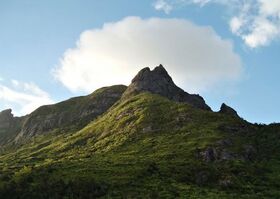Vekh Neramë: Difference between revisions
No edit summary |
m (→Name) |
||
| Line 37: | Line 37: | ||
==Name== | ==Name== | ||
In comparison to the nearby [[Vekh Lamanë]], the origin of Vekh Neramë’s name is unclear. An eighth-century mariner's guide from [[Azmir]] refers to ''Vaekhra Narmegga'' "in the islands of the west," and some believe that this should be identified with Vekh Neramë. It has furthermore been suggested that the name refers to [[Narma]], a minor Ethlorek deity associated with bonfires and hearths, although she does not appear in the surviving corpus of Cadenzan literature. The connection is regarded as plausible, but the authoritative Toponymic Inventory of Cadenza notes that "the argument is inconclusive." | In comparison to the nearby [[Vekh Lamanë]], the origin of Vekh Neramë’s name is unclear. An eighth-century mariner's guide from [[Azmir]] refers to ''Vaekhra Narmegga'' "in the islands of the west," and some believe that this should be identified with Vekh Neramë. It has furthermore been suggested that the name refers to [[Narma]], a minor Ethlorek deity associated with bonfires and hearths, although she does not appear in the surviving corpus of Cadenzan literature. The connection is regarded as plausible, but the authoritative Toponymic Inventory of Cadenza notes that "the argument is fundamentally inconclusive." | ||
==Geology== | ==Geology== | ||
Revision as of 06:20, 26 November 2020
| Vekh Neramë | |
|---|---|
 | |
| Highest point | |
| Elevation | 1,163 m (3,816 ft) |
| Prominence | 1,163 m (3,816 ft) |
| Listing | Country high point Something like Monroes but more Trellinese |
| Geography | |
| Parent range | Akar Tarpeg |
Vekh Neramë is the tallest mountain on the island of Cadenza. At 1,163 m (3,816 ft), it is the highest peak in the Akar Tarpeg, Cadenza's Central Range. It is the most westerly summit above 1,000 metres in the Trellinese Empire and the only mountain taller than 1,000 m in Cadenza. Vekh Neramë is 184 m (604 ft) taller than the next highest summit in Cadenza, Vekh Lamanë. An extinct volcano, it is not thought to have erupted since approximately 325,000 years ago.
Name
In comparison to the nearby Vekh Lamanë, the origin of Vekh Neramë’s name is unclear. An eighth-century mariner's guide from Azmir refers to Vaekhra Narmegga "in the islands of the west," and some believe that this should be identified with Vekh Neramë. It has furthermore been suggested that the name refers to Narma, a minor Ethlorek deity associated with bonfires and hearths, although she does not appear in the surviving corpus of Cadenzan literature. The connection is regarded as plausible, but the authoritative Toponymic Inventory of Cadenza notes that "the argument is fundamentally inconclusive."
Geology
Vekh Neramë is an extinct stratovolcano, initially formed during the Caddensian volcanic orogeny approximately 5 million years before present, when the Jajexan Plate traversed a hotspot in the Earth's asthenosphere. This hotspot now lies to the west of Cadenza and is responsible for ongoing volcanism offshore. The migration of the island away from the hotspot did not cause an immediate end to volcanism at Vekh Neramë, as fault line activity in Azmir continued to fuel Cadenza's volcanoes. In its most substantial known eruption, approximately 80% of Vekh Neramë's mass was ejected as tephra and smoke in one of the most significant volcanic events in Teudallic geological history. It is thought that the resulting ash cloud reduced global temperatures by 0.3 degrees Celsius. Mountain-building resumed following this eruption, with several episodes of dramatic change. Its last eruption, roughly 325,000 years ago, is thought to have had a VEI of 4. The surviving plug is composed of dense basalt, with large deposits of dark brown scoria and grey tephra on the flanks.
Geography
The base of the mountain begins about 200 m (660 ft) above sea level and climbs quickly, its tephra flanks reposing at 45 degrees for the first third of its ascent. The climb then becomes gentler, at 30 degrees, but the ground remains rough and tumbled and heavily vegetated. The summit of Vekh Neramë is a massive wedge of exposed basalt, with sheer faces on all sides and an almost vertical descent on the peak's northeast face.
Despite its notorious difficulty and numerous fatalities, mostly incurred on its northeast face, Vekh Neramë remains a popular climb. The summit is most commonly approached along the ridge from the northwest, by way of the gentler Vekh eg.
It gets windy